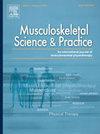Survey of rehabilitation practice for patients undergoing lumbar surgery in the United Kingdom
IF 2.2
3区 医学
Q1 REHABILITATION
引用次数: 0
Abstract
Purpose
National guidelines recommend rehabilitation for patients undergoing elective lumbar surgery, yet current provision within the UK is unknown. The aim of this study was to determine Physiotherapy practice regarding prehabilitation, peri-operative, and post-operative rehabilitation, for patients undergoing lumbar discectomy, laminectomy, and single-level fusion, within the UK.
Methods
Physiotherapists working within the UK were invited to complete a cross-sectional, descriptive online survey. Open and closed-ended questions enquired about aims, content, format, and frequency of rehabilitation. Quantitative data were analysed descriptively, and open-ended responses were analysed narratively.
Results
360 responses were received, revealing varied practices. Routine provision of prehabilitation was low (18 %) whereas peri-operative and post-operative rehabilitation was offered more frequently (>60 %). Rehabilitation was predominantly delivered in-person, on a one-to-one basis. Prehabilitation focused on educating patients and optimising psychological and physical health, peri-operative rehabilitation focused on safe mobility, and post-operative rehabilitation on improving function. Advice and education were the most common interventions across all rehabilitation phases. Exercise prescription was frequently used within peri-operative and post-operative rehabilitation. Post-operative restrictions were advised by 62 % of respondents. The most frequently provided activity restrictions were for lifting, driving, walking, sitting, and back movement, with timeframes varying considerably.
Conclusion
This study highlights considerable variation in access to and content of rehabilitation for patients undergoing lumbar surgery in the UK. While some variation may reflect personalised care, it also suggests uncertainty in the evidence base and inconsistent guideline use. Findings support the need for patient-centred pathways, updated UK-specific guidelines, and further research into implementation barriers, the impact of postoperative restrictions, and tailored rehabilitation interventions.
英国腰椎手术患者康复实践调查
目的:国家指南推荐接受择期腰椎手术的患者进行康复治疗,但英国目前的规定尚不清楚。本研究的目的是确定在英国进行腰椎间盘切除术、椎板切除术和单节段融合术的患者在康复前、围术期和术后康复方面的物理治疗实践。方法邀请在英国工作的物理治疗师完成一项横断面描述性在线调查。开放式和封闭式问题询问康复的目的、内容、形式和频率。定量数据采用描述性分析,开放式回答采用叙述性分析。结果共收到360份反馈,反映出不同的做法。常规提供的康复治疗很少(18%),而围手术期和术后康复治疗更频繁(60%)。康复主要以一对一的方式进行。康复前的重点是教育患者和优化心理和身体健康,围手术期康复的重点是安全活动,术后康复的重点是改善功能。咨询和教育是所有康复阶段最常见的干预措施。运动处方是围手术期和术后康复的常用处方。62%的应答者建议术后限制。最常见的活动限制是举重、开车、走路、坐着和背部活动,时间范围差异很大。结论:本研究强调了英国腰椎手术患者康复的途径和内容存在相当大的差异。虽然一些差异可能反映了个性化护理,但它也表明证据基础的不确定性和指南使用的不一致。研究结果支持需要以患者为中心的途径,更新英国特定指南,并进一步研究实施障碍,术后限制的影响,以及量身定制的康复干预措施。
本文章由计算机程序翻译,如有差异,请以英文原文为准。
求助全文
约1分钟内获得全文
求助全文
来源期刊

Musculoskeletal Science and Practice
Health Professions-Physical Therapy, Sports Therapy and Rehabilitation
CiteScore
4.10
自引率
8.70%
发文量
152
审稿时长
48 days
期刊介绍:
Musculoskeletal Science & Practice, international journal of musculoskeletal physiotherapy, is a peer-reviewed international journal (previously Manual Therapy), publishing high quality original research, review and Masterclass articles that contribute to improving the clinical understanding of appropriate care processes for musculoskeletal disorders. The journal publishes articles that influence or add to the body of evidence on diagnostic and therapeutic processes, patient centered care, guidelines for musculoskeletal therapeutics and theoretical models that support developments in assessment, diagnosis, clinical reasoning and interventions.
 求助内容:
求助内容: 应助结果提醒方式:
应助结果提醒方式:


